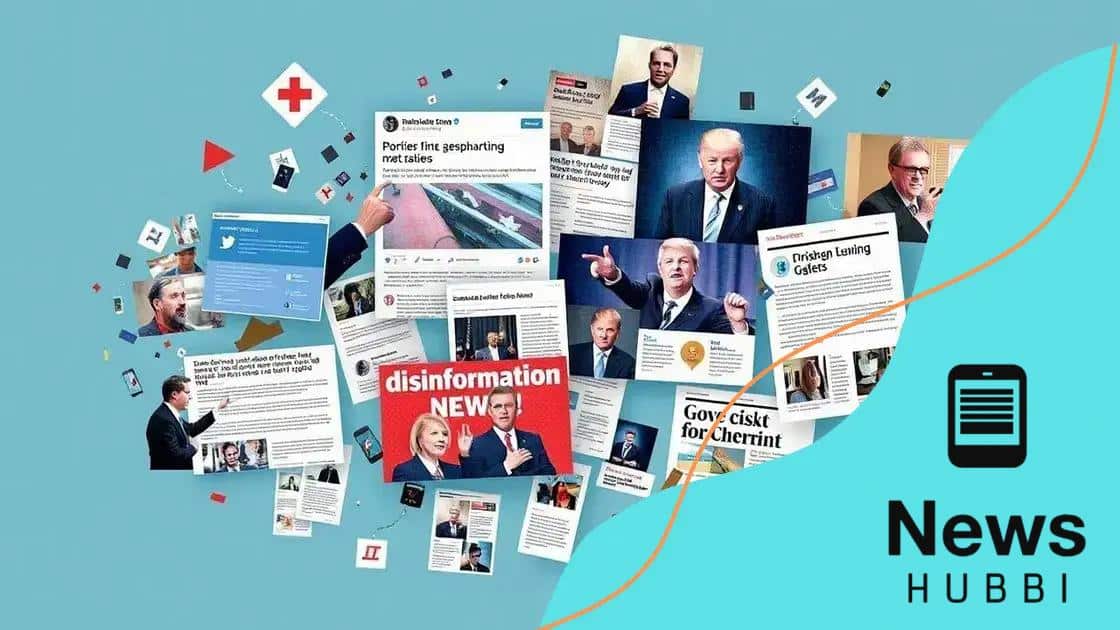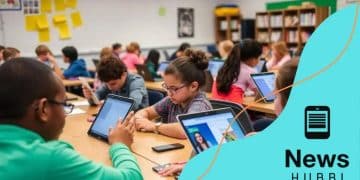Global strategies to combat disinformation: a comprehensive guide

Anúncios
Global strategies to combat disinformation include community engagement initiatives, media literacy education, and fact-checking efforts, all aimed at empowering individuals to recognize and resist misleading information effectively.
In an era where information spreads like wildfire, global strategies to combat disinformation have become essential. How do we discern fact from fiction? Let’s explore these critical approaches together.
Anúncios
Understanding the anatomy of disinformation
Understanding the anatomy of disinformation is crucial in today’s information-driven world. Disinformation isn’t just random falsehoods; it has a structure and purpose. Recognizing its components can help us identify and combat it effectively.
The key components of disinformation
Disinformation often comprises three main elements:
- Source: The origin of the false information, which can vary widely from individuals to large organizations.
- Message: The actual content that is being shared, which can be misleading, manipulated, or fabricated.
- Channel: The medium through which the disinformation spreads, such as social media, websites, or traditional media.
Understanding these elements can help individuals become more savvy consumers of information. Disinformation typically preys on emotions, such as fear or anger. By tapping into these feelings, it can spread rapidly and influence public opinion. It’s essential to analyze the context in which disinformation appears, as its effects can be more potent when it arrives during crises or significant events.
Anúncios
Identifying disinformation
To combat disinformation, we must first learn to identify its signs:
- Vague sources: If the source is unclear or anonymous, proceed with caution.
- Exaggerated claims: Be wary of messages that seem too good or bad to be true.
- Lack of evidence: Authentic information should be backed by credible evidence.
In conclusion, the anatomy of disinformation can be dissected to expose its structure and intent. By being aware of its components and methods, we can shield ourselves from its harmful effects and promote a more informed society.
The role of technology in spreading false information
The role of technology in spreading false information is significant and multifaceted. From social media platforms to algorithms, technology has changed how information is shared and consumed globally. Understanding this role is key to combating disinformation.
Social media platforms
Social media is one of the primary channels for the rapid spread of false information. These platforms allow users to share content in seconds, making it easy for misleading news to go viral. The algorithm used by these platforms often favors sensational content, which can further amplify false claims.
- Viral patterns: Misleading information can spread quicker than factual news, leading to widespread belief.
- User engagement: Posts that provoke strong emotional reactions are more likely to be shared.
- Echo chambers: Social media can create environments where users only see information that aligns with their beliefs.
Another technological factor in the spread of disinformation is the use of algorithms. These algorithms curate the content users see, which can inadvertently promote false narratives. When algorithms prioritize engagement over accuracy, users are often exposed to misleading information without realizing it.
Emerging technologies
Emerging technologies such as artificial intelligence also play a crucial role in disinformation. AI can generate realistic-looking content, making it easier to create and share false information that seems credible. Technologies like deepfakes illustrate how far this can go, causing significant confusion and distress.
Furthermore, while technology poses challenges, it can also be part of the solution. Tools that help verify information and flag false content are becoming more prevalent. By utilizing technology to enhance media literacy, we can equip individuals to better navigate the complex information landscape.
Case studies of successful disinformation campaigns

Case studies of successful disinformation campaigns reveal how effective misinformation can manipulate public opinion and behavior. These examples show the strategies employed and the impact they have on society.
The 2016 U.S. Presidential Election
One of the most notable cases of disinformation occurred during the 2016 U.S. presidential election. Social media played a key role in spreading false narratives about candidates. One major tactic involved creating fake news articles that were designed to mislead voters. These articles spread rapidly, often shared by users who believed them to be true.
- Targeting specific demographics: Campaigns targeted certain groups using data analytics to influence their thoughts and opinions.
- Emotional engagement: The content often played on emotions, like fear and anger, to make it more shareable.
- Manipulated images and videos: Altered visual content was also commonly used to mislead voters.
This disinformation not only affected voter behavior but also heightened divisions within the country, showcasing the massive reach and impact of media manipulation.
Anti-Vaccine Movement
The anti-vaccine movement is another significant example of how disinformation can affect public health. False information surrounding vaccines has led to decreased vaccination rates, resulting in the resurgence of preventable diseases.
The campaign was fueled by misleading studies and celebrity endorsements of false claims. Social media platforms served as channels for these ideas to spread, reaching vast audiences without a filter of factual accuracy. An important takeaway from this case study is:
- Echo chambers: Online groups fostered environments where doubts about vaccines flourished.
- Targeted misinformation: The misinformation was tailored to various audiences, tapping into specific fears.
- Disguised credibility: Some fake information was presented in professional formats, making it seem more legitimate.
These case studies underline the necessity of being vigilant in verifying information and understanding the dynamics of how misinformation spreads effectively.
Evaluating the effectiveness of current strategies
Evaluating the effectiveness of current strategies to combat disinformation is essential for improving our methods. Understanding what works and what doesn’t can help develop more robust approaches. Various strategies have emerged, but their impacts vary widely.
Media literacy programs
One prominent strategy involves education and media literacy programs. These programs aim to teach people how to critically evaluate information sources. By enhancing critical thinking skills, individuals can better discern fact from fiction. Here are some key aspects:
- Curriculum integration: Effective media literacy should be integrated into schools at an early age.
- Community workshops: Engaging workshops can help adults recognize disinformation.
- Online resources: Providing tools and resources online makes learning accessible for everyone.
These programs have shown promise in equipping people with the skills needed to navigate the current information landscape.
Fact-checking organizations
Another critical strategy includes the role of fact-checking organizations. These organizations work to verify claims made in the media and online. They play a significant role in distributing accurate information and debunking myths, helping hold media sources accountable. Key points include:
- Rapid response: Quick fact-checking helps correct misinformation before it spreads widely.
- Collaboration with platforms: Partnering with social media companies enhances the reach of fact-checking efforts.
- Public awareness: Promoting fact-checking resources increases public engagement with credible information.
While these efforts have had positive impacts, challenges remain. Misinformation can still spread quickly, often outpacing fact-checking initiatives. Additionally, public trust in fact-checkers varies, which can limit their effectiveness.
To sum up, evaluating the effectiveness of these strategies is crucial for understanding their strengths and areas for improvement. By learning from past efforts, we can better combat the pervasive threat of disinformation.
Community engagement and public awareness initiatives
Community engagement and public awareness initiatives are vital in the fight against disinformation. These efforts aim to inform and empower individuals to recognize and resist misleading information. Through various activities, communities can work together to create a more informed public.
Community workshops
Hosting workshops is an effective way to educate the public about disinformation. These sessions can provide valuable skills for identifying false information. Workshop topics may include:
- Spotting fake news: Learning how to differentiate between credible news sources and misleading articles.
- Fact-checking tools: Introducing tools and resources that help verify information before sharing.
- Critical thinking skills: Teaching participants to analyze information critically.
These hands-on experiences promote engagement and help communities become more media literate. As people share their newfound knowledge, they create a ripple effect in their networks.
Social media campaigns
Social media campaigns also play an essential role in raising awareness. By leveraging popular platforms, organizations can reach a broad audience and spread important messages. Some effective tactics include:
- Interactive content: Quizzes and polls that help users learn about disinformation.
- Infographics: Visually engaging materials that summarize key information about identifying false claims.
- Community hashtags: Encouraging users to share their stories related to misinformation using specific hashtags.
These campaigns can drive engagement by making the audience feel involved. They not only raise awareness but also foster discussion around important topics.
Engagement efforts, combined with effective public awareness initiatives, can significantly enhance a community’s ability to tackle disinformation. By working together, the public can build resilience against the influence of misleading information.
In conclusion, combating disinformation requires a collective effort from communities, organizations, and individuals. Strategies like community engagement and public awareness initiatives play a crucial role in building resilience. By educating ourselves and others, we can be more critical consumers of information. The fight against disinformation is ongoing, but with the right tools and a motivated community, we can create a more informed society. Together, we can ensure that accurate information prevails over misleading narratives.
FAQ – Frequently Asked Questions about Community Engagement and Disinformation
What are community engagement initiatives?
Community engagement initiatives involve activities that educate and empower individuals to recognize and resist disinformation.
How can social media help combat disinformation?
Social media can spread awareness and share facts quickly, educating a large audience about how to identify misleading information.
Why is media literacy important?
Media literacy helps people develop critical thinking skills, enabling them to evaluate sources and content effectively.
What role do fact-checkers play in fighting disinformation?
Fact-checkers verify claims and help correct misinformation before it spreads widely, maintaining public trust in accurate information.





